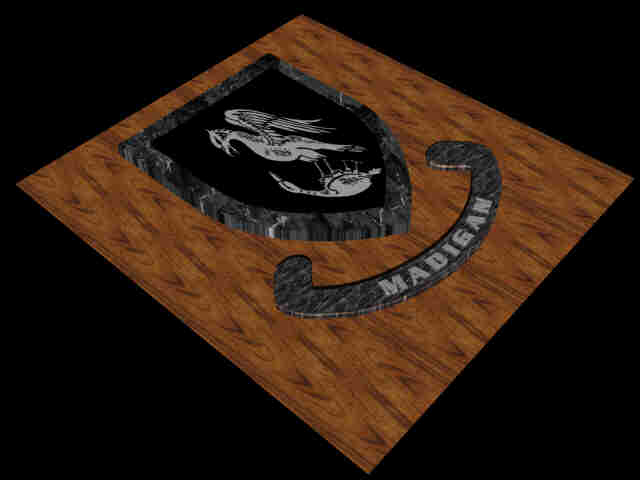One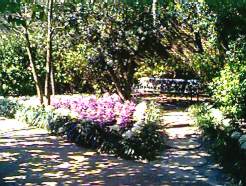 might not think
at first that there would be much in bloom in the middle of
February in this part of the country. Nothing could be further
from the truth. Having passed through the entrance gate, I was
impressed by the various types of flowering Kale used in
bordering the walkways. We made our way to the Great Lawn which
was guarded by a solitary topiary standard bearer. This
beautifully manicured field stretches hundred of yards toward the
river and the gardens on the right side of the house.
might not think
at first that there would be much in bloom in the middle of
February in this part of the country. Nothing could be further
from the truth. Having passed through the entrance gate, I was
impressed by the various types of flowering Kale used in
bordering the walkways. We made our way to the Great Lawn which
was guarded by a solitary topiary standard bearer. This
beautifully manicured field stretches hundred of yards toward the
river and the gardens on the right side of the house. 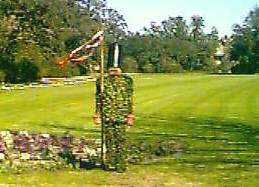 The use of
water, both functional and as accent and divider, is superb as we
walked alongside trickling brooks and over bridges. The front of
the house is very close to the river’s edge leaving little
area for development. A pier stretches out into the river to
facilitate the landing of the cruise boat that visits during the
warmer months.
The use of
water, both functional and as accent and divider, is superb as we
walked alongside trickling brooks and over bridges. The front of
the house is very close to the river’s edge leaving little
area for development. A pier stretches out into the river to
facilitate the landing of the cruise boat that visits during the
warmer months. 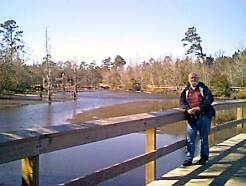 The left side of the house
leads to a boardwalk and observation platforms built later as a
bayou estuary, and animal preserve. The largest of the platforms
is built in gazebo style utilizing a palm leaf roof that had
deteriorated long ago, giving a feeling of quiet solitude. We
found ourselves alone on the shelter bench curled up against each
other warding off the imaginary loneliness of our surroundings.
The left side of the house
leads to a boardwalk and observation platforms built later as a
bayou estuary, and animal preserve. The largest of the platforms
is built in gazebo style utilizing a palm leaf roof that had
deteriorated long ago, giving a feeling of quiet solitude. We
found ourselves alone on the shelter bench curled up against each
other warding off the imaginary loneliness of our surroundings.
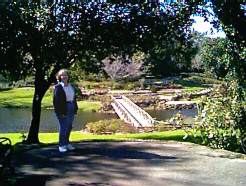 Continuing past the Bayou, we entered the paved pathways
meandering through the many gardens that run for what seems like
miles in the rear of the house. Mirror lake, a long sliver of
water which transverses the many themes was generously adorned
with the waterfowl of the area. There was even a natural spring
bubbling forth on a slight rise on the far side of the lake. Well
developed natural visual barriers, prevented us from seeing from
one theme to another.
Continuing past the Bayou, we entered the paved pathways
meandering through the many gardens that run for what seems like
miles in the rear of the house. Mirror lake, a long sliver of
water which transverses the many themes was generously adorned
with the waterfowl of the area. There was even a natural spring
bubbling forth on a slight rise on the far side of the lake. Well
developed natural visual barriers, prevented us from seeing from
one theme to another. 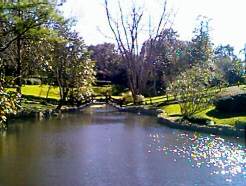 This was most effective over
the lake as we were not able to see down the lake from one place
to another. There was always a turn or object strategically
placed, blocking the view. Of particular interest was the
Japanese garden with its tea house and bridges. The only
non-instructive sign is to be found here. Hanging on the back
wall in large Japanese lettering is the word “Coca
Cola”.
This was most effective over
the lake as we were not able to see down the lake from one place
to another. There was always a turn or object strategically
placed, blocking the view. Of particular interest was the
Japanese garden with its tea house and bridges. The only
non-instructive sign is to be found here. Hanging on the back
wall in large Japanese lettering is the word “Coca
Cola”.
The house itself is a magnificent structure built from handmade
bricks acquired from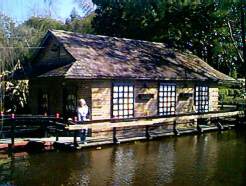 the home where Alva
Vanderbilt was born. The ironworks came from an old waterfront
hotel in Mobile that was built in the Eighteen hundreds. Many of
the fifteen rooms within, are furnished with the antiques
acquired by Bessie. Several of these items can be identified to
their specific owners such as the 20 piece parlor set once owned
by Madame Pontaba, the creator of New Orleans’ famed Jackson
Square, or The Chippendale banquet table and chairs once owned by
Sir Thomas Lipton of English Tea fame. The house is visited by
guided tour only for an extra charge.
the home where Alva
Vanderbilt was born. The ironworks came from an old waterfront
hotel in Mobile that was built in the Eighteen hundreds. Many of
the fifteen rooms within, are furnished with the antiques
acquired by Bessie. Several of these items can be identified to
their specific owners such as the 20 piece parlor set once owned
by Madame Pontaba, the creator of New Orleans’ famed Jackson
Square, or The Chippendale banquet table and chairs once owned by
Sir Thomas Lipton of English Tea fame. The house is visited by
guided tour only for an extra charge. 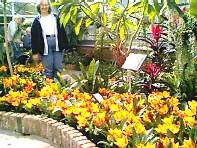 There are many
other structures of notable interest. A Gallery, displaying a
collection of porcelain sculptures by Edward Boehm. A chapel,
originally used by the Bellingraths, and a greenhouse which at
the time displayed a wonderful variety of orchids. A day at the
gardens most likely will last three or four hours, but with the
exception of a bridge or two, the walk was easy and appeared to
be handicap accessible.
There are many
other structures of notable interest. A Gallery, displaying a
collection of porcelain sculptures by Edward Boehm. A chapel,
originally used by the Bellingraths, and a greenhouse which at
the time displayed a wonderful variety of orchids. A day at the
gardens most likely will last three or four hours, but with the
exception of a bridge or two, the walk was easy and appeared to
be handicap accessible.
To check out the specific details, scheduling, entrance fees, and what's going on right now in the Bellingrath Gardens and Home, check out the link to this horticultural delight's web page at http://www.Bellingrath.org.
. . . THE END . . .

